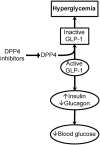Stress Hyperglycemia in Critically Ill Patients: Insight Into Possible Molecular Pathways
- PMID: 30972338
- PMCID: PMC6445875
- DOI: 10.3389/fmed.2019.00054
Stress Hyperglycemia in Critically Ill Patients: Insight Into Possible Molecular Pathways
Abstract
Severe sepsis, systemic inflammatory response syndrome (SIRS), and traumatic brain injury are frequently associated with hyperglycemia in non-diabetic patients. In patients suffering from any of these conditions, hyperglycemia at admission to an intensive care unit (ICU) is directly correlated with increased mortality or morbidity. Although there was initial enthusiasm for insulin treatment to blood glucose levels below 110 mg/dL in these patients, recent understanding suggests that the potential for hypoglycemic complications make this approach potentially dangerous. More moderate glucose control seems to be more beneficial than the aggressive glucose lowering initially suggested. An important publication has shown that hyperlactatemia accompanying hyperglycemia could be the real culprit in bad outcomes. This suggests that coupling moderate glucose lowering with therapeutic agents which might treat the underlying metabolic disturbances in these conditions may be a better strategy. The key metabolic disturbance in these three conditions seems to be persistent glycolysis as an energy source even in the presence of adequate tissue oxygenation (the Warburg Effect). We look at recent advances in understanding aerobic glycolysis and possibly the action of DPP4 on incretins resulting in insulin dysregulation and suggest key metabolic pathways involved in hyperglycemia regulation.
Keywords: Warburg effect; dipeptidyl peptidase IV; glycolysis; hyperglycemia; oxidative phosphorylation; sepsis.
Figures


References
LinkOut - more resources
Full Text Sources
Research Materials
Miscellaneous

